Description
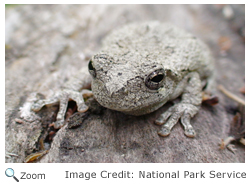 The gray treefrog is about two inches in length. It is green, gray, or brown in color. It can be a solid color, or it can have blotches on its back. The gray treefrog is about two inches in length. It is green, gray, or brown in color. It can be a solid color, or it can have blotches on its back.
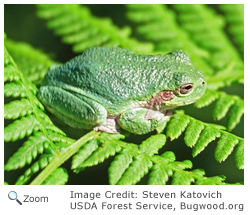 The gray treefrog can change its color in seconds. It tends to become darker when it is cold or dark. Its coloring helps it blend in with tree bark! It has a white underside and lots of warts. It has large, sticky toe pads that help it cling to tree bark and other surfaces. It has bright yellow to orange skin under its thighs. The gray treefrog can change its color in seconds. It tends to become darker when it is cold or dark. Its coloring helps it blend in with tree bark! It has a white underside and lots of warts. It has large, sticky toe pads that help it cling to tree bark and other surfaces. It has bright yellow to orange skin under its thighs.
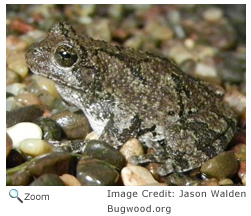 There is another species of tree frog, Cope's gray treefrog, that looks exactly like the gray treefrog. You can tell them apart by their calls. The gray treefrog's call has a slower trill that is more musical the the Cope's treefrog's call.
The gray treefrog is also a little larger than the Cope's gray treefrog; and it has bumpier skin.
Scientists can tell the difference between the two species because the gray treefrog has
twice as many chromosomes as Cope's gray treefrogs. There is another species of tree frog, Cope's gray treefrog, that looks exactly like the gray treefrog. You can tell them apart by their calls. The gray treefrog's call has a slower trill that is more musical the the Cope's treefrog's call.
The gray treefrog is also a little larger than the Cope's gray treefrog; and it has bumpier skin.
Scientists can tell the difference between the two species because the gray treefrog has
twice as many chromosomes as Cope's gray treefrogs.
Range
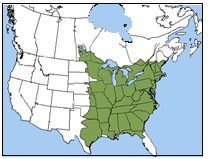 The gray treefrog is found from Manitoba east to Maine and south to northern Florida and central Texas. The gray treefrog is found in New Hampshire. The gray treefrog is found from Manitoba east to Maine and south to northern Florida and central Texas. The gray treefrog is found in New Hampshire.
|
|
Habitat
The gray treefrog lives in moist, deciduous woodlands and swamps near water. It is also found in pine barrens.
Diet
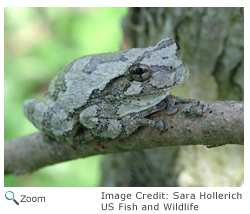 The gray treefrog finds its food in trees and shrubs. It eats moths, tree crickets, ants, flies, grasshoppers, and beetles. It is very acrobatic and often jumps from branch to branch to catch its prey. The gray treefrog finds its food in trees and shrubs. It eats moths, tree crickets, ants, flies, grasshoppers, and beetles. It is very acrobatic and often jumps from branch to branch to catch its prey.
Life Cycle
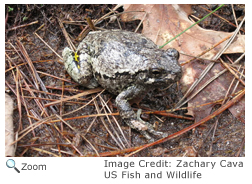 Breeding season runs from April to August. Males gather in trees and bushes next to breeding ponds and swamps and begin calling. The male aggressively defends its territory from intruders. The female selects a mate based on his call. She lays her eggs on the surface of shallow water in ponds or swamps. She may also lay her eggs in standing water in tire ruts, vernal pools, or even swimming pools! The eggs are attached to vegetation to keep them from floating away. The female lays as many as 2,000 eggs in groups of 10-40 eggs. The tadpoles hatch in 4-5 days and change into froglets in about two months. Breeding season runs from April to August. Males gather in trees and bushes next to breeding ponds and swamps and begin calling. The male aggressively defends its territory from intruders. The female selects a mate based on his call. She lays her eggs on the surface of shallow water in ponds or swamps. She may also lay her eggs in standing water in tire ruts, vernal pools, or even swimming pools! The eggs are attached to vegetation to keep them from floating away. The female lays as many as 2,000 eggs in groups of 10-40 eggs. The tadpoles hatch in 4-5 days and change into froglets in about two months.
Behavior
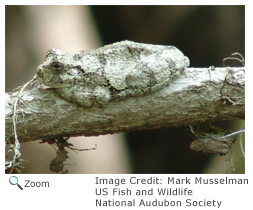 The gray treefrog is nocturnal. It spends the day resting in trees and shrubs. At night, it crawls among the branches and leaves looking for food. It usually only comes out of the trees and bushes during the breeding season. In the winter, it hibernates under leaves, bark, or rocks on the forest floor. The gray treefrog is nocturnal. It spends the day resting in trees and shrubs. At night, it crawls among the branches and leaves looking for food. It usually only comes out of the trees and bushes during the breeding season. In the winter, it hibernates under leaves, bark, or rocks on the forest floor.
The gray treefrog freezes in the winter! It produces large amounts of glycerol. The glycerol is changed to glucose, and then it is circulated through the frog's cells. The glucose acts like a kind of antifreeze and prevents ice crystals from forming in the frog's cells. If ice crystals formed in the cells, they would rip the cells apart and kill the frog. The rest of the water and blood in the frog's body then freezes, and its heartbeat and breathing stop! When the temperature warms up, the tree frog "thaws out" and returns to the trees!
|




 The gray treefrog is found from Manitoba east to Maine and south to northern Florida and central Texas. The gray treefrog is found in New Hampshire.
The gray treefrog is found from Manitoba east to Maine and south to northern Florida and central Texas. The gray treefrog is found in New Hampshire.

